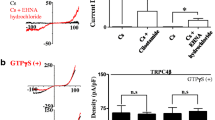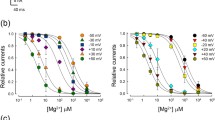Abstract
Transient receptor potential canonical (TRPC) 4 channels are calcium-permeable, nonselective cation channels and are widely expressed in mammalian tissue, especially in the GI tract and brain. TRPC4 channels are known to be involved in neurogenic contraction of ileal smooth muscle cells via generating cationic current after muscarinic stimulation (muscarinic cationic current (mIcat)). Polyamines exist in numerous tissues and are believed to be involved in cell proliferation, differentiation, scar formation, wound healing, and carcinogenesis. Besides, physiological polyamines are essential to maintain inward rectification of cardiac potassium channels (Kir2.1). At membrane potentials more positive than equilibrium potential, intracellular polyamines plug the cytosolic surface of the Kir2.1 so that potassium ions cannot pass through the pore. Recently, it was reported that polyamines inhibit not only cardiac potassium channels but also nonselective cation channels that mediate the generation of mIcat. Here, we report that TRPC4, a definite mIcat mediator, is inhibited by intracellular spermine with great extent. The inhibition was specific to TRPC4 and TRPC5 channels but was not effective to TRPC1/4, TRPC1/5, and TRPC3 channels. For this inhibition to occur, we found that glutamates at 728th and 729th position of TRPC4 channels are essential whereby we conclude that spermine blocks the TRPC4 channel with electrostatic interaction between negative amino acids at the C-terminus of the channel.






Similar content being viewed by others
References
Akbulut Y, Gaunt HJ, Muraki K, Ludlow MJ, Amer MS, Bruns A, Vasudev NS, Radtke L, Willot M, Hahn S, Seitz T, Ziegler S, Christmann M, Beech DJ, Waldmann H (2015) Englerin A is a potent and selective activator of TRPC4 and TRPC5 calcium channels. Angew Chem Int Ed Engl 54(12):3787–3791
Beech DJ (2005) TRPC1: store-operated channel and more. Pflugers Arch - Eur J Physiol 451:53–60
Beech DJ (2007) Canonical transient receptor potential 5. Handb Exp Pharmacol 179:109–123
Cao E, Liao M, Cheng Y, Julius D (2013) TRPV1 structures in distinct conformations reveal activation mechanisms. Nature 504(7478):113–118
Casero RA, Marton LJ (2007) Targeting polyamine metabolism and function in cancer and other hyperproliferative diseases. Nat Rev Drug Discov 6:373–390
Fakller B, Brandle U, Glowatzki E, Weidemann S, Zenner HP, Ruppersberg JP (1995) Strong voltage-dependent inward rectification of inward rectifier K+ channels is caused by intracellular spermine. Cell 80:149–154
Ficker E, Taglialatela M, Wible BA, Henley CM, Brown AM (1994) Spermine and spermidine as gating molecules for inward rectifier K+ channels. Science 266:1068–1072
Flockerzi V, Nilius B (2014) TRPs: truly remarkable proteins. Handb Exp Pharmacol 222:1–12
Freichel M, Tsvilovskyy V, Camacho-Londono JE (2014) TRPC4- and TRPC4-containing channels. Handb Exp Phamacol 222:85–128
Huang CW, Kuo CC (2014) The bundle crossing region is responsible for the inwardly rectifying internal spermine block of the Kir2.1 channel. Pflugers Arch - Eur J Physiol 466(2):275–293
Inoue R, Isenberg G (1990) Acetylcholine activates nonselective cation channels in guinea pig ileum through a G protein. Am J Physiol 258:C1173–C1178
Jeon JP, Hong C, Park EJ, Jeon JH, Cho NH, Kim IG, Choe H, Muallem S, Kim HJ, So I (2012) Selective Gαi subunits as novel direct activators of transient receptor potential canonical (TRPC)4 and TRPC5 channels. J Biol Chem 287(21):17029–17039
John RM, Stevenson WG (2015) Ventricular arrhythmias. In. Kasper DL (ed) Harrison's principle of internal medicine, 19th edn. McGraw Hill, New York, pp 1489–1500
Kang TM, Kim YC, Sim JH, Rhee JC, Kim SJ, Uhm DY, So I, Kim KW (2001) The properties of carbachol-activated nonselective cation channels at the single channel level in guinea pig gastric myocytes. Jpn J Pharmacol 85(3):291–298
Kim J, Kwak M, Jeon JP, Myeong J, Wie J, Hong C, Kim SY, Jeon JH, Kim HJ, So I (2014) Isoform- and receptor-specific channel property of canonical transient receptor potential (TRPC)1/4 channels. Pflugers Arch - Eur J Physiol 466:491–504
Kim YC, Kim SJ, Sim JH, Cho CH, Juhnn YS, Suh SH, So I, Kim KW (1998) Suppression of the carbachol-activated nonselective cationic current by antibody against alpha subunit of Go protein in guinea-pig gastric myocytes. Pflugers Arch - Eur J Physiol 436(3):494–496
Kubo Y, Murata Y (2001) Control of rectification and permeation by two distinct sites after the second transmembrane region in Kir2.1 K+ channel. J Physiol 531(3):645–660
Lee KP, Jun JY, Chang IY, Suh SH, So I, Kim KW (2005) TRPC4 is an essential component of the nonselective cation channel activated by muscarinic stimulation in mouse visceral smooth muscle cells. Mol Cell 20(3):435–441
Liao M, Cao E, Julius D, Cheng Y (2013) Structure of the TRPV1 ion channel determined by electron cryo-microscopy. Nature 504(7478):107–112
Linsalata M, Orlando A, Russo F (2014) Pharmacological and dietary agents for colorectal cancer chemoprevention: effects on polyamine metabolism (review). Int J Oncol 45(5):1802–1812
Lopatin AN, Makhina EN, Nichols CG (1994) Potassium channel block by cytoplasmic polyamines of potassium channels: “long-pore plugging” by cytoplasmic polyamines. J Gen Physiol 106:923–955
Mery L, Magnino F, Schmidt K, Krause KH, Dufour JF (2001) Alternative splice variants of hTrp4 differentially interact with the C-terminal portion of the inositol 1,4,5-triphosphate receptors. FEBS Lett 487(3):377–383
Miehe S, Bieberstein A, Arnould I, Ihdene O, Rutten H, Strubing C (2010) The phospholipid-binding protein SESTD1 is a novel regulator of the transient receptor potential channels TRPC4 and TRPC5. J Biol Chem 285(16):12426–12434
Mignon-Ravix C, Cacciagli P, Choucair N, Popovici C, Missirian C, Milh M, Megarbane A, Busa T, Julia S, Girard N, Badens C, Siguady S, Philip N, Villard L (2014) Intragenic rearrangements in X-linked intellectual deficiency: results of a-CGH in a series of 54 patients and identification of TRPC5 and KLHL15 as potential XLID genes. Am J Med Genet A 164A(8):1991–1997
Nilsson BO, Hellstrand P (1993) Effects of polyamines on intracellular calcium and mechanical activity in smooth muscle of guinea-pig taenia coli. Acta Physiol Scand 148:37–43
Obukhov AG, Nowycky MC (2005) A cytosolic residue mediates Mg2+ block and regulates inward current amplitude of a transient receptor potential channel. J Neurosci 25(5):1234–1239
Odell AF, Van Helden DF, Scott JL (2008) The spectrin cytoskeleton influences the surface expression and activation of human transient receptor potential channel 4 channels. J Biol Chem 283(7):4395–4407
Onodera K, Unemoto T, Miyaki K, Hayashi M (1968) Pharmacological studies on polyamines. I. Relaxing effect of spermine and spermidine on smooth muscle of guinea pig ileum contracted by 5-hydroxytryptamine and nicotine. Arch Int Pharmacodyn Ther 174:491–494
Otsuguro K, Tang J, Tang Y, Xiao R, Freichel M, Tsvilovskyy V, Ito S, Flockerzi V, Zhu MX, Zholos AV (2008) Isoform-specific inhibition of TRPC4 channel by phosphatidylinositol 4,5-bisphoshate. J Biol Chem 283(15):10026–10036
Pegg AE (2014) The function of spermine. IUBMB Life 66(1):8–18
Priori SG, Pandit SV, Rivolta I, Berenfeld O, Ronchetti E, Dhamoon A, Napolitano C, Anumonwo J, Barletta MR, Gudapakkam S, Bosi G, Badiale MS, Jalife J (2005) A novel form of short QT syndrome (SQT3) is caused by a mutation in the KCNJ2 gene. Circulation 96:800–807
Sakamoto T, Unno T, Kitazawa T, Taneike T, Yamada M, Wess J, Nishimura M, Komori S (2007) Three distinct muscarinic signaling pathways for cationic channel activation in mouse gut smooth muscle cells. J Physiol 582:41–61
So I, Ashmole I, Soh H, Park CS, Spencer PJ, Leyland M, Stanfield PR (2003) Intrinsic gating in inward rectifier potassium channels (Kir2.1) with low polyamine affinity generated by site directed mutagenesis. Korean J Physiol Pharmacol 7:131–142
Stanfield PR, Sutcliffe MJ (2003) Spermine is fit to block inward rectifier (Kir) channels. J Gen Physiol 122(5):481–484
Tang J, Lin Y, Zhang Z, Tikunova S, Birnbaumer L, Zhu MX (2001) Identification of common binding sites for calmodulin and inositol 1,4,5-triphosphate receptors on the carboxyl termini of trp channels. J Biol Chem 276(24):21303–21310
Thompson PA, Wertheim BC, Zell JA, Chen WP, McLaren CE, Lafleur BJ, Meyskens FL, Gerner EW (2010) Levels of rectal mucosal polyamines and prostaglandin E2 predict ability of DFMO and sulindac to prevent colorectal adenoma. Gastroenterology 139:797–805
Trost C, Bergs C, Himmerkus N, Flockerzi V (2001) The transient receptor potential, TRP4, cation channel is a novel member of the family of calmodulin binding proteins. Biochem J 335:663–670
Tsvilovskyy VV, Zholos AV, Aberle T, Philipp SE, Dietrich A, Zhu MX, Birnbaumer L, Freichel M, Flockerzi V (2009) Deletion of TRPC4 and TRPC6 in mice imparis smooth muscle contraction and intestinal motility in vivo. Gastroenterology 137:1415–1424
Tsvilovskyy VV, Zholos AV, Bolton TB (2004) Effects of polyamines on the muscarinic receptor-operated cation current in guinea-pig ileal smooth muscle myocytes. Br J Pharmacol 143:968–975
Wang W, Liu LQ, Higuchi CM (1996) Mucosal polyamine measurements and colorectal cancer risk. J Cell Biochem 63(2):252–257
Zholos AV (2014) TRPC5. Handb Exp Phamacol 222:129–156
Zholos AV, Zholos AA, Bolton TB (2004) G-protein-gated TRP-like cationic channel activated by muscarinic receptors: effect of potential on single-channel gating. J Gen Physiol 123(5):581–598
Zhu MX (2005) Multiple roles of calmodulin and other Ca2 + −binding proteins in the functional regulation of TRP channels. Pflugers Arch - Eur J Physiol 451:105–115
Acknowledgments
We thank Dr. Michael Mederos and Dr. Thomas Gudermann for kindly donating human TRPC1 isoform long (hTRPC1α) construct. TRPC5 were kindly donated by Dr S. Kaneko and Dr Y. Mori. TRPC4 were kindly donated by Dr V. Flockerzi and Dr. M. Schaefer.
This study was supported by grants from the National Research Foundation of Korea, which is funded by the Ministry of Science, ICT (Information & Communication Technology) and Future Planning (MSIP) of the Korean Government (MSIP) (2013R1A1A1010783) (K.P. Lee), (2012R1A2A1A01003073) (I. So). Y. S. was supported by the BK21 plus program from the MSIP. This work was supported by the Education and Research Encouragement Fund of Seoul National University Hospital (I. So).
Author information
Authors and Affiliations
Corresponding authors
Ethics declarations
Conflict of interest
The authors declare that they have no competing interests.
Additional information
Jinsung Kim and Sang Hui Moon contributed equally to this work.
Electronic supplementary material
Below is the link to the electronic supplementary material.
Supplementary Figure 1
Effect of intracellular spermidine and putrescine to TRPC4 channel. (a), (b) all left panels indicate current traces and right panels indicate corresponding I-V curves at noted points (1, 2 and 3). 1 mM of spermidine and putrescine could not inhibit TRPC4 channel as strong as spermine. There was no asymmetry between outward current and inward current as was in spermine. Both polyamines, however, somewhat slowed down the activation process. (PPTX 202 kb)
Supplementary Figure 2
Intracellular spermine inhibit TRPC3 with nonspecific manner. (a) Normalized current density of TRPC3 channels. White circle indicates currents without spermine and black circle indicates current with intracellular spermine. Two currents showed indifferent I-V shape. (b) Current density of TRPC3 current with and without intracellular spermine. Intracellular spermine reduced both inward and outward current density of TRPC3 channels. (c) Current trace for TRPC3 recording. Muscarinic acetylcholine receptor 3 and extracellular carbachol (CCh, 100 μM) was used for activation of TRPC3 channels. In addition, divalent-free solution (DVF) was used in the activation process. (PPTX 106 kb)
Supplementary Figure 3
Distribution of negative amino acids in C-terminus of TRPC4 channel. (a) Amino acid sequence of C-terminus of TRPC4 channel. Red capitals indicate negative amino acids (D and E), green capitals indicate TRP box sequence (EWKFAR) and gray capitals indicate alternative splicing site for TRPC4β. (b) Left panel, From 621st amino acid to 890th amino acid in TRPC4β, negative amino acids showed sporadic distribution when window width was set to 20 amino acids. When 740th amino acid was set as cut-off number, however, distribution of negative amino acids showed clear stratification. (PPTX 65 kb)
Supplementary Figure 4
Effect of high magnesium ([Mg2+]i = 10 mM) on TRPC4 channels. (a) I-V curves for whole-cell TRPC4 current with 10 mM of intracellular Mg2+. Augmented intracellular Mg2+ could not alter the shape of I-V curves. (b) Representative current race of TRPC4 current under 10 mM intracellular Mg2+. Activation kinetics were similar to physiological condition ([Mg2+]i ∼ 3 mM). (PPTX 390 kb)
Rights and permissions
About this article
Cite this article
Kim, J., Moon, S.H., Shin, YC. et al. Intracellular spermine blocks TRPC4 channel via electrostatic interaction with C-terminal negative amino acids. Pflugers Arch - Eur J Physiol 468, 551–561 (2016). https://doi.org/10.1007/s00424-015-1753-x
Received:
Revised:
Accepted:
Published:
Issue Date:
DOI: https://doi.org/10.1007/s00424-015-1753-x




